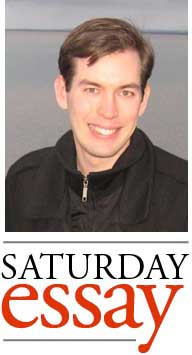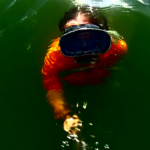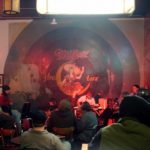A Lament for Liquor Lyle’s
 I asked my friend to describe the strangely named bar that he said was our destination for the night. He paused, frowned, and sought out the right analogy.
I asked my friend to describe the strangely named bar that he said was our destination for the night. He paused, frowned, and sought out the right analogy.
“Well,” he said, “It’s as if a 1950s diner met a hunting shack.”
So began my first visit to Liquor Lyle’s, an establishment just south of Hennepin Avenue’s corner with Franklin Avenue in the Wedge neighborhood of Minneapolis. A year later I moved into an apartment next door, and for my two years in the Twin Cities, Lyle’s became the hub of my social life, the one place that could summon a crowd with a simple text: “Lyle’s?”
It hosted grad-school study sessions and end-of-semester blowouts and many a nightcap after a long night on the town. A handful of young alumni turned it into a Georgetown bar when the Hoyas made the NCAA Men’s Basketball Tournament in 2015. Whenever one of us left the city, Lyle’s was the home to the last party, and after I went on my way, no return to Minneapolis was complete without at least one night in that dark, lovable hole. In town for a professional conference in Minneapolis some years ago, I dragged a group to the bar and blended a few of my worlds. After another day of state hockey, we would decamp there to relax, maybe lure in a few friends who weren’t into hockey to catch up with them, too. My last bar experience before the COVID-19 outbreak took me to Lyle’s after the last night of the 2020 tourney. At least I know I was one of the last people to enjoy it.
Liquor Lyle’s was the platonic ideal of a dive bar. Its entrance was vaguely tomblike, a descent into an underworld lined by sparkly red vinyl booths. Above one sat a plaque commemorating a proposal from decades ago, a happy couple lording over revelers down the years. The grime from down the ages coated the black-and-white tiled floor. The graffiti along the urinal trough was first-class. The bartenders rarely changed, and the bouncer never did. (Curiously, he absolutely refused to accept passports as valid IDs, ruining one night with an out-of-town friend.) A tray of Girl Scout cookies always sat on the ledge by the door next to him, free for the taking.
Lyle’s welcomed everyone, and its human menagerie delighted those of us whose own crowds have always contained multitudes. Wander in at 4 p.m. on a weekday and a group of regulars line the rectangular bar, occupying stools they had probably occupied since the place opened in 1963. A grungy, musically-inclined crowd often packed the booths toward the back of the main room. Sometimes the Uptown bros were out in force, or a bachelorette party rolled through near the end of the night. My roommate in the apartment where we lived next door, who had the bedroom in the corner of the building immediately opposite Lyle’s, occasionally enjoyed loud, drunken breakups that were amusing enough to make up for the lost sleep. Sometimes, stepping out the next morning for an early run, I’d find a few dead soldiers on our front stoop. Never have I looked upon litter so fondly.
No matter how far my friends and I wandered in those years, the night ended at Lyle’s, a return to the homely comforts of its burgers and the Tetris Tots. Also on the menu was a mystery beer, though they discontinued that a few years back. My friend J., who lived on the other side of the place, took home the last one they ever served. The mystery beer was, inevitably, a Magic Hat. The bar’s most famous deal, however, was its ubiquitous two-for-ones, which actually proved problematic when the place briefly imposed a $10 minimum to use credit cards. Your four drinks cost less than $10? Ah well, what’s two more?
Two-for-one veterans knew always to ask for bottles to maximize volume. Grain Belt bottles, sometimes coated in dust, were my go-to: no other drink quite fit the mood of a Minneapolis dive. Woe unto the visitor who expected a high-end rail drink: the beer list was passable, but no one went to Lyle’s for the flavor. They went for the company. The Otter may have better karaoke and the Moose may have the wackiest crowd and the CC Club may have “Closing Time,” but no other bar quite fit the city like this old windowless gem, or provided the same sense of home.
As urban planners, my friends and I had a lingering fear that Lyle’s might not be long for the world. It was clearly a holdout from a different era, a funny little piece of dated real estate on a corridor that was enjoying a burst of density. The demise of Nye’s on the other side of downtown and the steady conversion of Uptown meant the writing was on the bathroom wall, most likely scratched in with an off-color joke. But we held out hope that Lyle’s would remain Lyle’s. Alas, it was not to be: Lyle’s is for sale now, uncertain whether it will survive in its present, precious form, felled in part by a changing city and a pandemic that has taken far too many sources of beauty from this world, but primarily, it seems, by the simple march of time for its aging owners.
For years from now, though, I will return stray nights at Lyle’s in my mind, trace back those old paths of a younger self. You and your crew toss open the door, wait as the bouncer whips out his mini-flashlight and strains to find some defect in your ID. Some football game is on in the bar, and the crowd erupts at all the right times. The bar overflows, its stools packed deep and a ring of thirsty standing around the edge. In the area behind the divide, a large group has pulled the tables together, maybe midway through a game of Jenga with the set that required embarrassing or expensive tasks on each block removed from the tower. (If someone tried to pick you up at Lyle’s, there was half a chance your suitor would have a Jenga tile in hand.) Tish, the server in dreads and chains, fetches your beer at the table that forms your temporary home. In the back room, someone who has never shot a gun in his life is playing Big Buck Hunter while the pool sharks put the rest of us in our places. Someone cranks Toto’s “Africa” on the jukebox and follows it with a string of bands from your youth. Two of your friends suddenly disappear, later to reveal themselves as a couple, love born at two for the price of one. Right there, on a barstool amid the cacophony, you just might find yourself spilling out your soul to a friend as you never have before. At closing time, the lights slowly come on, and your party works its way out to the sidewalk, where stray groups linger and jaw at each other in the night, awaiting their Ubers or readying their plods back down the streets of Uptown.
I can only assume that when Nathan Heller penned these lines a few years back he was dreaming of a night at Lyle’s:
The shock of the twenties is how narrow that window of experience really is, and how inevitable it seems both at the time and afterward. At some point, it is late, too late, and you are standing on the sidewalk outside somewhere very loud. A wind is blowing. It’s the same cool, restless late-night breeze that blew on trampled nineteen-twenties lawns, dazed sixties streets, and anywhere young people gather. Nearby, someone who doesn’t smoke is smoking. An attractive stranger with a lightning laugh jaywalks between cars with a friend, making eye contact before scurrying inside. You’re far from home. It’s quiet. All at once, you have a thrilling sense of nowness, of the sheer potential of a verdant night with all these unmet people in it. For a long time after that, you think you’ll never lose this life, those dreams. But that was, as they say, then.
Karl Schuettler spits out occasional thoughts on A Patient Cycle, a blog that offers his take on a perfectly logical combination of topics such as Duluth-area affairs, the exploits of high school kids playing hockey, experiments in fiction, and anything else that wanders into his head.
Recommended Links:
Leave a Comment
Only registered members can post a comment , Login / Register Here














No Comments